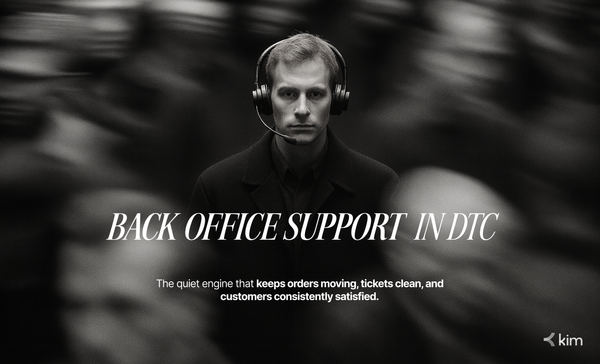The Role of Customer Feedback in Enhancing DTC Support Systems
Leverage customer feedback to fuel DTC brand success! Kim.cc analyzes vast amounts of customer interactions to uncover hidden insights & trends, empowering DTC brands to make data-driven decisions & win the competitive edge.

Imagine being able to listen in on every customer conversation but without the time commitment. Kim.cc makes this a reality! Our AI tool analyzes vast amounts of customer interactions, uncovering hidden insights and trends you might otherwise miss. Stop guessing about what your customers want - Kim.cc delivers actionable data to transform your DTC business.
Key Takeaways
- Why Customer Feedback is Essential for DTC Brands
- Types of Customer Feedback and How to Collect It
- Analyzing and Acting on Customer Feedback
- Tools and Technologies for Efficient Customer Feedback Management
- Building a Customer-Centric Support Culture
Why Customer Feedback is Essential for DTC Brands
Think of customer feedback as the voice of your audience, a direct line to understanding their needs, wants, and pain points. By actively collecting and analyzing this feedback, DTC brands can unlock a treasure trove of insights that fuel strategic decision-making across the board. Here's why customer feedback is essential for DTC success:
- Improved User Experience (UX): Customer feedback helps you identify areas where your website, app, or overall user experience can be improved. Is the checkout process cumbersome? Is product information clear and concise? Feedback reveals these friction points, allowing you to refine your offerings for a smoother customer journey.
- Enhanced Product Development: Direct customer input is invaluable for product development. Feedback can highlight desired features, expose product weaknesses, and even spark ideas for entirely new product lines.
- Boosted Customer Satisfaction: Actively seeking and responding to customer feedback demonstrates that you value their opinion. This fosters trust and builds stronger customer relationships, ultimately leading to higher satisfaction and repeat purchases.
- Competitive Advantage: By leveraging customer feedback to continuously improve your offerings, you gain a significant edge over competitors. You'll be able to address customer needs faster, personalize the shopping experience, and ultimately deliver a superior value proposition.
For an in-depth exploration of how customer feedback can elevate your DTC user experience, check out this insightful article: Decoding Customer Feedback: Strategies for Enhanced User Experience.
Types of Customer Feedback and How to Collect It
Customer feedback comes in many forms, and the most effective strategy involves utilizing a multi-pronged approach. Here are some key types of feedback and methods for collecting them:
- In-App/Website Surveys: Short, targeted surveys embedded within your app or website can gather valuable insights on specific customer interactions.
- Post-Purchase Feedback Emails: Following a purchase, send a quick email requesting feedback on the product and overall shopping experience.
- Live Chat Interactions: Train your live chat support team to actively solicit feedback during customer interactions.
- Social Media Listening: Monitor brand mentions and conversations on social media platforms to understand customer sentiment and identify emerging trends.
- Direct Support Tickets: Analyze customer support tickets to pinpoint recurring issues and areas for improvement.
- Customer Reviews: Encourage customers to leave reviews on product pages and other relevant platforms. While not always controlled, reviews offer valuable customer perspectives.
Pro Tip: Remember, the key to effective feedback collection is to make it easy and convenient for customers to participate. Keep surveys concise, offer multiple-choice options, and ensure feedback channels are readily accessible. Make data-driven decisions with Kim. Our AI analyzes conversations to reveal customer sentiment, identify pain points, and inform your business strategies.
For a more comprehensive understanding of DTC customer service strategies, you can refer to this informative resource: DTC Brands: How to Deliver Exceptional Customer Service.
Analyzing and Acting on Customer Feedback
Collecting customer feedback is just the first step. To unlock its true potential, you need a systematic approach to analyzing and acting upon it. Here's how:
- Categorize Feedback: Group similar feedback together based on theme or topic. This helps identify recurring issues and prioritize areas for improvement.
- Identify Trends: Look for patterns and common threads within the feedback data. This can reveal broader customer frustrations or unmet needs.
- Prioritize Actions: Not all feedback holds equal weight. Analyze the severity and frequency of issues to prioritize which ones need to be addressed first.
- Develop Action Plans: Once you've identified key areas for improvement, create concrete action plans with timelines and responsible parties assigned.
- Communicate with Customers: Let your customers know you're listening! Respond to feedback, acknowledge concerns, and outline steps you're taking to address them. This transparency builds trust and demonstrates your commitment to customer satisfaction.
Remember, customer feedback is an ongoing process. Regularly analyze and act upon feedback to ensure continuous improvement and a consistently exceptional DTC experience.
Tools and Technologies for Efficient Customer Feedback Management

Managing customer feedback across various channels can be overwhelming. Thankfully, several powerful tools and technologies can streamline the process:
- Customer Relationship Management (CRM) Systems: CRMs allow you to centralize all customer interactions, including feedback, in one place. This makes it easier to track trends, analyze data, and assign ownership for addressing concerns.
- Customer Feedback Management (CFM) Software: Dedicated CFM software provides advanced functionalities specifically designed for capturing, analyzing, and responding to customer feedback. These tools can automate surveys, categorize feedback, and generate insightful reports.
- Social Listening Platforms: These platforms help you monitor brand mentions and conversations across social media channels, providing real-time insights into customer sentiment and emerging trends.
- Help Desk Software: Streamline your customer support operations with help desk software. This allows you to manage support tickets efficiently, categorize feedback within tickets, and track resolution times.
By utilizing these tools, DTC brands can gain a holistic view of their customer feedback, leading to more informed decision-making and a more responsive customer support experience.
Building a Customer-Centric Support Culture
Building a customer-centric support culture is paramount for leveraging customer feedback effectively. Here's how to foster this culture within your DTC brand:
- Empower Your Support Team: Train your support team to actively listen to customer feedback, empathize with customer concerns, and take ownership of resolving issues.
- Recognize and Reward Feedback Champions: Acknowledge and reward team members who consistently go above and beyond to collect and act upon customer feedback.
- Integrate Feedback into Performance Reviews: Hold your team accountable by incorporating customer feedback metrics into performance reviews. This incentivizes a focus on continuous improvement.
- Make Feedback Accessible Across Departments: Ensure customer feedback is readily available to all relevant departments, including product development, marketing, and sales. This fosters a collaborative approach to addressing customer needs.
By fostering a customer-centric support culture, your DTC brand transforms customer feedback from a data point into a powerful tool for driving positive change across your organization.
Conclusion
Customer feedback is the lifeblood of DTC's success. By actively collecting, analyzing, and acting upon customer feedback, you can continuously improve your offerings, build stronger customer relationships, and gain a significant competitive edge. Remember, a commitment to customer feedback demonstrates that your DTC brand truly cares about its customers, ultimately leading to long-term success and customer loyalty.




